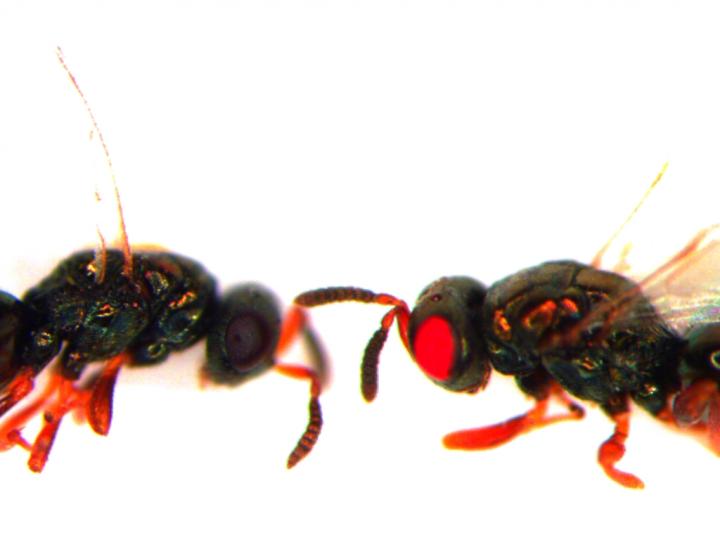Researchers create red-eyed mutant wasps

The red-eyed mutant Jewel wasp, seen on the right, was created in the lab using CRISPR technology. An unmodified Jewel wasp is seen on the left. Credit: Akbari lab
Researchers at UC Riverside's Akbari lab have brought a new strain of red-eyed mutant wasps into the world.
The wasps were created to prove that CRISPR gene-slicing technology can be used successfully on the tiny parasitic jewel wasps, giving scientists a new way to study some of the wasp's interesting biology, such as how males can convert all their progeny into males by using selfish genetic elements.
No one knows how that selfish genetic element in some male wasps “can somehow kill the female embryos and create only males,” said Omar Akbari, an assistant professor of entomology who led the research team. “To understand that, we need to pursue their PSR (paternal sex ratio) chromosomes, perhaps by mutating regions of the PSR chromosome to determine which genes are essential for its functionality.”
Enter the relatively new CRISPR technology, which allows scientists to inject components like RNA and proteins into an organism with instructions to find, cut and mutate a specific piece of DNA. Then researchers can see how disrupting that DNA affects the organism.
The end goal, in Akbari's case, is to better understand the biology of wasps and other insects, so they can find a way to control insects that destroy crops or spread diseases like malaria.
But the first step is figuring out how to use the CRISPR technology in such a small organism, something no one had ever done before, in large part because the work is pretty daunting, Akbari said. This is because jewel wasps lay their tiny eggs inside a blowfly pupa, which had to be peeled back to expose the teensy eggs.
How tiny? Imagine the blowfly egg sac as about the size of a small bean, Akbari said, and Jewel wasp eggs “about a quarter the size of a grain of rice….You're essentially pulling a small egg out of a larger egg, injecting it with components to mutate the DNA and then putting it back into the bigger egg to develop.”
In the case of Akbari's mutant wasps, the team decided to slice the genes that control the color of the wasp's normally black eyes.
“We wanted to target a gene that would be obvious, and we knew from previous studies that if the gene for eye pigmentation was knocked out, they would have red eyes, so this seemed like a good target for gene disruption,” Akbari said. “Big beautiful red eyes are something you won't miss.”
But creating that disruption took some doing–well, a lot of doing, Akbari said. “You have to use a very-very fine needle and a microscope and individually inject hundred to thousands of embryos, but in the end, we developed a protocol that can be used to cut the DNA in this organism and we showed that it works.”
The technique is challenging, Akbari said, “but it is learnable. You need a really steady hand and it requires a lot of patience in micro manipulation that one can learn over time. Ming Li, a postdoctoral researcher in our lab has mastered the technique.”
And those scarlet-orbed wasps? They won't be going away anytime soon. The cuts in the DNA created a mutant wasp with heritable traits, which means those red eyes will be passed down to all their offspring in the future – an important quality for researchers who are looking for a stable line of insects to study.
###
The results were just published in Nature's Scientific Reports in an article called “Generation of heritable germline mutations in the jewel wasp Nasonia vitripennis using CRISPR/Cas9.” Besides Akbari, the authors include Li, Abigail Chong and Bradley J. White of UCR and Lauren Yun Cook Au, Deema Douglah and Patrick M. Ferree from Claremont McKenna College in Claremont.
The research was supported by UCR startup funds.
Media Contact
All latest news from the category: Life Sciences and Chemistry
Articles and reports from the Life Sciences and chemistry area deal with applied and basic research into modern biology, chemistry and human medicine.
Valuable information can be found on a range of life sciences fields including bacteriology, biochemistry, bionics, bioinformatics, biophysics, biotechnology, genetics, geobotany, human biology, marine biology, microbiology, molecular biology, cellular biology, zoology, bioinorganic chemistry, microchemistry and environmental chemistry.
Newest articles

NASA: Mystery of life’s handedness deepens
The mystery of why life uses molecules with specific orientations has deepened with a NASA-funded discovery that RNA — a key molecule thought to have potentially held the instructions for…

What are the effects of historic lithium mining on water quality?
Study reveals low levels of common contaminants but high levels of other elements in waters associated with an abandoned lithium mine. Lithium ore and mining waste from a historic lithium…

Quantum-inspired design boosts efficiency of heat-to-electricity conversion
Rice engineers take unconventional route to improving thermophotovoltaic systems. Researchers at Rice University have found a new way to improve a key element of thermophotovoltaic (TPV) systems, which convert heat…



